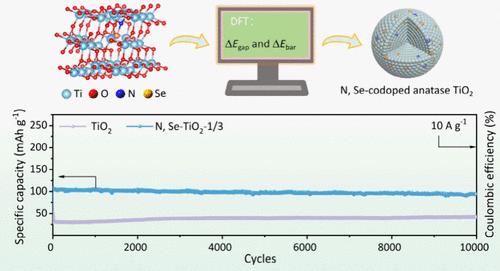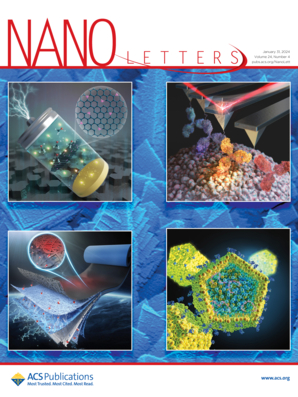DFT-Guided Design of Dual Dopants in Anatase TiO2 for Boosted Sodium Storage
IF 9.6
1区 材料科学
Q1 CHEMISTRY, MULTIDISCIPLINARY
引用次数: 0
Abstract
Anatase titanium dioxide (TiO2) has drawn great attention as an anode material in sodium ion batteries (SIBs), but it suffers from the sluggish diffusion kinetics of Na+ within TiO2 and inferior electronic conductivity. Herein, under the guidance of density functional theory (DFT), we propose a nitrogen and selenium dual-doped TiO2 system as an advanced SIB anode. Both DFT and experimental investigations reveal the cooperative effect of dopants in boosting the electrochemical performance of TiO2, finding the optimal content ratio (N/Se at 1:3) for overall improved SIB performances. As expected, experimental results exhibit excellent sodium storage behavior of the N,Se-doped TiO2, including high discharge capacity (142 mAh g–1 at 2 A g–1), good rate performance (82 mAh g–1 at 20 A g–1), and ultralong cyclability (97% retention over 5000 cycles at 2 A g–1). Our study underscores the importance of dual-heteroatom doping in the rational design of advanced electrode materials.

在 DFT 引导下设计斜长石二氧化钛中的双掺杂剂以提高钠储量
无相性二氧化钛(TiO2)作为钠离子电池(SIB)的负极材料备受关注,但它存在 Na+ 在 TiO2 内扩散速度慢、电子导电性差等问题。在此,我们在密度泛函理论(DFT)的指导下,提出了一种氮硒双掺杂 TiO2 系统作为先进的 SIB 负极。DFT 和实验研究揭示了掺杂剂在提高 TiO2 电化学性能方面的协同作用,并找到了全面提高 SIB 性能的最佳含量比(N/Se 为 1:3)。正如预期的那样,实验结果表明掺杂了 N、Se 的 TiO2 具有优异的钠存储性能,包括高放电容量(2 A g-1 时为 142 mAh g-1)、良好的速率性能(20 A g-1 时为 82 mAh g-1)和超长循环性(2 A g-1 时 5000 次循环保持率为 97%)。我们的研究强调了双杂原子掺杂在先进电极材料合理设计中的重要性。
本文章由计算机程序翻译,如有差异,请以英文原文为准。
求助全文
约1分钟内获得全文
求助全文
来源期刊

Nano Letters
工程技术-材料科学:综合
CiteScore
16.80
自引率
2.80%
发文量
1182
审稿时长
1.4 months
期刊介绍:
Nano Letters serves as a dynamic platform for promptly disseminating original results in fundamental, applied, and emerging research across all facets of nanoscience and nanotechnology. A pivotal criterion for inclusion within Nano Letters is the convergence of at least two different areas or disciplines, ensuring a rich interdisciplinary scope. The journal is dedicated to fostering exploration in diverse areas, including:
- Experimental and theoretical findings on physical, chemical, and biological phenomena at the nanoscale
- Synthesis, characterization, and processing of organic, inorganic, polymer, and hybrid nanomaterials through physical, chemical, and biological methodologies
- Modeling and simulation of synthetic, assembly, and interaction processes
- Realization of integrated nanostructures and nano-engineered devices exhibiting advanced performance
- Applications of nanoscale materials in living and environmental systems
Nano Letters is committed to advancing and showcasing groundbreaking research that intersects various domains, fostering innovation and collaboration in the ever-evolving field of nanoscience and nanotechnology.
 求助内容:
求助内容: 应助结果提醒方式:
应助结果提醒方式:


